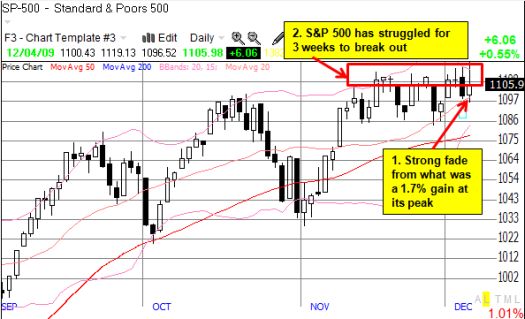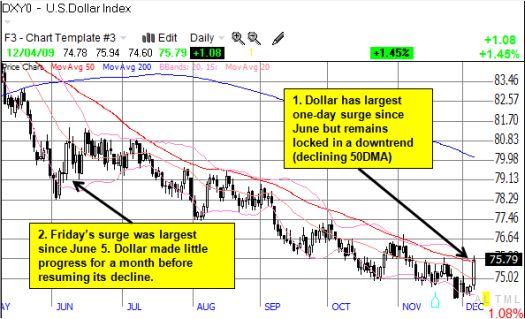Good (or not as bad as expected) economic news has typically garnered selling in the U.S. dollar and buying in the stock market. On Friday, the good news that November’s monthly change in U.S. non-farm payrolls came in essentially flat sent the S&P 500 soaring as high as 1.7%. However, the dollar index also soared, ending the day with a 1.5% gain. It took 30 minutes, but the market did respond to the stronger dollar by selling off for the rest of the day. The S&P 500 faded and ended the day with a much smaller 0.6% gain. The intra-day action suggests that a stronger dollar still means a weaker stock market. The daily action suggests the inverse correlation may have finally broken.


*All charts created using TeleChart: 
Trading in the coming days and weeks should provide some clarity on the status of this long-standing inverse correlation between the U.S. dollar and almost every asset on the planet. The Financial Times’s “Short View” suggests that there is no direct evidence that leverage, aka the carry trade against the dollar, has driven asset values upward this year. If this is truly the case, the stock market may indeed continue upward even as the dollar strengthens. The Federal Reserve also meets next week (Dec 15-16) and will get its first chance to comment on recent developments.
In the meantime, we are left to question whether the Federal Reserve will tighten monetary policy earlier than usual and really put this inverse correlation to the test. Traders and investors are always trying to get a jump on future events, and Friday’s move in the dollar implies that anticipation is building that rates will go higher next year. We can mainly thank Federal Reserve Bank of St. Louis President James Bullard for putting this possibility on the radar.
Bullard caused a stir two weeks ago after he simply reminded everyone that after “’…the last two recessions, in each case the FOMC waited two and a half to three years before we started our tightening campaign…If we took that as a benchmark, that would put us in the first half of 2012.’” Although the severity of the last recession was much more like the recession of the early 1980s, that recession was at least partially caused by raising rates as the Federal Reserve actively fought against the inflation of the 1970s. (Click here for a chart comparing the unemployment rate to the Federal funds rate from 1954-2009.)
Bullard also acknowledged that leaving rates too low for too long can create asset bubbles. I was surprised to see a member of the Federal Reserve acknowledge that the long delay in raising rates after the last two recessions helped create asset bubbles: technology stocks in the 1990s and then the housing bubble this decade. This time around, the Federal Reserve’s lax policies appear likely to support the ever-growing bubble in U.S. government debt…unless something dramatic changes sometime soon (not likely – short of some kind of default anyway).
Bullard was somehow able to create another stir when he spoke on interest rates the day before Friday’s NFP release. He suggested that if a jobless recovery is now the new normal, the Fed would have to consider increasing rates earlier than usual: “If a tepid recovery in labor markets is just the new reality … then you shouldn’t be saying, ‘oh, we are just going to keep interest rates where they are,'” based on labor market issues.” (Click here for a brief review of the persistent weakness in the payroll data following the end of the last two recessions). Overall, it is not clear whether Bullard supports raising rates early (he is not a voting member until next year), but he does seem to be sowing seeds for further debate within the Federal Reserve. I remain extremely skeptical that the Federal Reserve will break from past practice.
The main problem I have is that time and again during the last bull market, the economy proved itself dependent on, even addicted to, easy money and cheap credit. For example, personal savings consistently declined along with interest rates starting in the mid-1980s (click here for descriptive graphs). Although personal savings have finally increased again, this latest crisis has done little to change this structural weakness. Some argue that the monetary and fiscal remedies during this last financial crisis have only further entrenched this weakness.
The Federal Reserve’s job is made more difficult by the persistence of tight credit conditions despite accommodative monetary policies. For example, commercial real estate particularly continues to suffer and 2010 promises to be another tough year. Moreover, until the inverse correlation between the U.S. dollar and the stock market reverses, the Federal Reserve will be extremely hesitant to break its post-recession monetary patterns by tightening policy and supporting the dollar. After doing everything it could to prop up asset prices, the Federal Reserve does not want to become (directly) responsible for driving them back down. I still expect the Fed to prefer risking the creation of new bubbles (and inflation) rather than risk sending the economy right back into a recession…nevermind that bubbles always burst and usher in the next scourge of economic weakness.
Other resources:
The New York Fed provides a historical account of interest rates
U.S. unemployment rate since 1990
Monthly change in non-farm payrolls since 1939
Be careful out there!
Full disclosure: long SSO puts

3 thoughts on “As Unemployment Finally Appears to Crest, Monetary Policy Reaches A Critical Juncture”